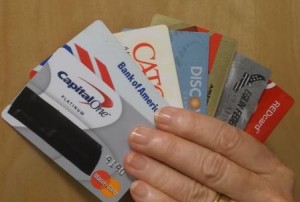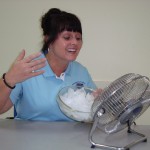by Amy Mullins, PhD, RDN | Sep 11, 2013

With healthy lifestyle changes, many people with pre-diabetes can restore their blood glucose to normal levels.
Chances are, most of us have a friend or family member who is diabetic. Type-2 diabetes develops when the body is unable to use the hormone insulin properly, causing blood glucose to stay high after eating (hyperglycemia). If left untreated, hyperglycemia can cause serious complications such as heart disease and stroke, high blood pressure, kidney disease, nervous system disease and even amputations and blindness. The American Diabetes Association reports that diabetes is responsible for more deaths in the U.S. per year than breast cancer and AIDS combined.
According to the Centers for Disease Control (CDC), almost 26 million Americans already have diabetes and another 79 million (35% of our population) have a condition known as pre-diabetes. Pre-diabetes is a condition where blood glucose levels are not quite high enough to be diabetic, but are definitely at a level to cause concern. It is reported that 15% to 30% of people with pre-diabetes will likely develop type 2 diabetes within five years.
So, what is behind this diabetes epidemic? It turns out that the increase in diabetes and pre-diabetes cases mirrors the increased number of overweight and obese Americans. The CDC reports that 80% to 90% of people with type-2 diabetes are also considered overweight or obese.
The good news is that with healthy lifestyle changes, many people with pre-diabetes can restore their blood glucose to normal levels. A 3-year diabetes prevention study of over 3,000 subjects, conducted by the Centers for Disease Control (CDC), demonstrated the power of maintained weight loss in lowering the risk for type-2 diabetes. Participants that adopted healthy eating habits (like reduction of dietary fat) and increased physical activity (150 minutes minimum equivalent to brisk walking) were able to reduce their body weight by 7%. This modest, and sustained, weight reduction significantly improved the body’s ability to use insulin and process glucose, lowering the risk of type-2 diabetes.
Often, people with pre-diabetes do not show any symptoms and may not even know there is cause for concern. The American Diabetes Association recommends that if you are overweight (BMI>25) with one or more of the following risk factors you should be tested by your health care provider:
- Older than age 45
- Physically inactive
- A parent, brother, or sister with diabetes
- African American, Alaska Native, American Indian, Hispanic, Pacific Islander
- History of gestational diabetes or had >9 lb. baby
- High blood pressure (140/90 or higher)
- HDL cholesterol <35mg/dL or triglycerides >250mg/dL
- History of polycystic ovary syndrome
- History of cardiovascular disease
If you are pre-diabetic, making wise lifestyle changes can drastically improve your health and delay or prevent type-2 diabetes. Remember to talk to your doctor before making any major changes to your diet or exercise patterns. Consider these tips to improve your weight management:
- Eat less fat, especially saturated and trans fats (fatty meats, whole milk and dairy products, processed bakery items, margarine, fried foods)
- Eat more whole grains and beans to increase your fiber
- Eat a variety of fruits and vegetables (fresh is best, but frozen or canned count too)
- Reduce processed foods with added sugars and sodium
- Keep an eye on portions to reduce your volume or calories (and fat!)
- Eat several small meals and snacks throughout the day instead of eating large meals
- Stop eating when you feel satisfied
- Drink water throughout the day!
- Get up and be active! Start a walking program slowly, then pick up the pace
If you want to learn more about preventing and managing pre-diabetes, visit
http://www.cdc.gov/diabetes/consumer/index.htm
If you don’t know what your Body Mass Index (BMI) is, check out the CDC BMI Calculator
Interested in Healthy Meal Planning and Cooking with Diabetes? Sign up for a 2-hour workshop offered on the following dates:
October 9th 6:00 pm at the Leon County Extension Office (call 850-606-5200 to register)
October 14th 6:00 pm at the Wakulla County Extension Office (call 850-926-3931 to register)
October 29th 6:00 pm at the Liberty County Extension Office (call 850-643-2229 to register)
Nov. 12th 6:00 pm at the Jefferson County Extension Office (call 850-342-0187 to register)
by amandangriffin | Sep 10, 2013
Wouldn’t it be great to have dinner ready tonight when you walk in the door? Can you smell the aroma of the roast, potatoes, carrots, bell pepper, and onion as you open the front door of your home? Slow cookers make having dinner on busy days or after work quick and easy.
There are various types of slow cookers. You can buy slow cookers with multiple crocks. The multiple crocks are great for game day parties to hold chili, cheeses, or dips! Some slow cookers have different heat settings like high, medium, and low and need to be turned off manually. Others have actual temperature settings or timers that shut off or switch to a warming setting automatically.

Use a slow cooker to have dinner ready for your family when you get home.
Some benefits of the slow cooker include:
1. Your kitchen does not get as hot as it does using the oven.
2. The low heat tenderizes less expensive, leaner cuts of meat and reduces shrinkage.
3. You can transport your food in the same crock, thus keeping the heat in the food. When you use the oven, you have to remove the food from the heat source, resulting in much heat loss en route to your destination.
Slow cookers do have some disadvantages as well. Some vitamins and minerals are lost from vegetables due to the long slow cooking process. When foods are cooked quickly at a high temperature, the enzymes are deactivated so there are minimal nutrients lost. So, if you plan on using your slow cooker for vegetables, give them a quick blanch to keep from losing too many nutrients.
Cleanup is easier with the slow cooker, especially if you use the bag inserts available from your local grocer. The slow cooker is easily stored out of the way and is a great way to “fix it and forget it” until it is time to eat. I wish I had something cooking in mine right now!
For more information on the slow cooker:
FCS80001/FY1288: Keeping Food Safe: Preparing and Cooking
FCS80001-Span/FY1292: Manteniendo los alimentos seguros
by Elaine Courtney | Sep 4, 2013

Credit card debt is something that hangs over many Americans. According to the Federal Reserve, in April 2013, the average credit card debt equaled $3,364 per U.S. adult. This assumes that EVERY adult has a credit card and that those cards carry debt. Of course, not all adults own a credit card. Young Americans are among those ditching their credit cards.
The only way to reduce credit card debt is to make payments each month and not add to that debt. The main way to reduce this even faster is to pay more than the minimum payment each month.
Save Nearly $4,000 by Paying More than the Minimum Balance
By only paying the minimum monthly balance, you are guaranteed to pay this debt for a longer time and pay more in total cost. For example:
|
Total Credit Card Debt
|
Monthly Payment
|
Years to Pay Off
|
Total Cost
|
|
$3,364 (at 14.96% Interest)
|
$67.28 (min. payment)
|
19 Years 5 Months
|
$7,618.63
|
|
$3,364 (at 14.96% Interest)
|
$87.28 (min. payment +$20)
|
4 Years 4 Months
|
$4,533.67
|
|
$3,364 (at 14.96% Interest)
|
$107.28 (minimum payment +$40)
|
3 Years 4 Months
|
$4,225.11
|
|
$3,364 (at 14.96% Interest)
|
$167.28 (minimum payment +$100)
|
1 Year 1 Month
|
$3,841.40
|
Similar information is available on your monthly credit card statement. It will identify how long it will take you to pay your debt if you only pay the minimum or if you pay a little extra. More info on how to read your bill is found at: http://www.federalreserve.gov/creditcard/flash/readingyourbill.pdf
You also can use an online calculator to determine costs and payoff information.
http://www.federalreserve.gov/creditcardcalculator/
Want to avoid the minimum payment trap completely? Follow these tips from financial experts:
- Know What You Owe – Make a list of all outstanding debt balances with the names of creditors, monthly payments, and APRs (interest rates).
- Run the Numbers – Use the Minimum Payment Calculator http://www.federalreserve.gov/creditcardcalculator/ and calculate the cost of making minimum and larger payments on various amounts of debt.
- Use a “power payment” to pay off your debt. Visit http://powerpay.org/
- Read the Numbers – Check your credit card statements about the cost of making minimum payments.
- Pay Cash – Instead of making new purchases with a credit card and adding them to outstanding balances, save up and pay cash (or use a debit card) to avoid interest charges.
- Set a Goal – To know how much to save, set a target date and dollar amount and work backwards. For example, $3,000 for a big screen television in a year requires weekly savings of about $58 ($3,000 ÷ 52).
In the example above, finding an extra $100 a month to apply to credit card payments reduces the time it will take you to pay off this debt from over 19 years to just over one year AND saves you nearly $4,000.
Need help finding ways to save? Take the Florida Saves pledge to make a commitment to yourself to save and to receive emails and/or text messages to keep you motivated.
Contact your local UF/IFAS County Extension office to find more ways and resources to help you manage your money. Be sure to join us for the Women & Money Program Oct. 1, 8, & 15!
by Dorothy C. Lee | Aug 22, 2013

Fuel your brain with a healthy, balanced breakfast.
Waking up is hard enough to do, but it is especially difficult for people who are not “morning” people, who would like to avoid that time of day altogether, and who don’t generally want breakfast. Nevertheless, the sun is still going to rise, people still have to get up, and breakfast still is the most important meal of the day. Because traditional meals play a significant role in providing daily recommended levels of essential nutrients, nutritionists often cite breakfast as the day’s most important meal and as the foundation of healthy eating habits.
Despite these recommendations, millions of Americans, in the rush to get to work, school, and other activities, often skip breakfast, thinking there is not enough time to prepare and eat a good well-balanced morning meal. Studies show that eating habits developed during childhood have the potential to last a lifetime, and children who tend to omit breakfast will likely continue this dietary habit well into adulthood. Studies also have shown that eating breakfast is associated with improved strength and endurance throughout the day and a better attitude toward school or work.
The role of breakfast in helping children perform at peak levels in the classroom was first documented more than 45 years ago at the University of Iowa Medical College. Researchers found that children who skipped breakfast had trouble concentrating at school and often became inattentive, irritable, restless, and fatigued by late morning—all behaviors counterproductive to learning. The behaviors were linked to low blood sugar levels which had not been replenished by a morning meal.
Breakfast helps to replenish blood glucose levels, which is important since the brain itself has no reserves of glucose, its main energy source. Sustained mental activity requires a large turnover of brain glucose and its metabolic components. After a fast of eight or nine hours, refueling at breakfast will make you feel and perform better during the day.
Here are some quick tips to help you avoid the temptation to be a breakfast skipper:
- No time? Build a breakfast around foods that are ready-to-eat or take little preparation time. For example: fresh and canned fruits; milk; yogurt; cheese; cottage cheese; ready-to-eat cold cereals; fruit smoothies; and instant breakfast mixes.
- Take it to go. Try celery stuffed with a meat or cheese spread or peanut butter; dried fruits; vegetable juices; or yogurt.
- Perk up cereals. Top cereals with fruit or stir chopped nuts, such as walnuts or almonds, into cooked cereals. Try adding dried fruit or granola.
- Not hungry yet? Drink juice or a fruit smoothie. Something is better than nothing! Have some bread or crackers later in the morning, then drink some milk and eat some cheese, an egg, or some peanut butter.
- Don’t skip breakfast if you’re on a diet. There is no evidence that skipping meals will help you lose weight. In fact, studies show that most people who skip breakfast tend to eat more later in the day. Some may even unintentionally select more calorie-dense foods.
Balanced breakfast choices can help provide the healthy edge needed for optimal physical and cognitive performance for children as well as adults. For those who don’t yet eat breakfast, it’s never too late to wake up to a healthy start!
For more breakfast suggestions, check out Breakfast Ideas and Breakfast on the Go.
Reference: United States Department of Agriculture, Human Nutrition Information Service
by Angela Hinkle | Aug 14, 2013
Brutal … Sizzling … Searing. These words are often used to describe the summer heat in our Southern region of the U.S. While staying cool in the summer heat is a matter of comfort for most of us, for many folks, excessive exposure to heat can be very dangerous. Here are some easy-to-follow tips to stay cool and prevent heat-related illnesses during the hot summer months.

Create a cool breeze with a fan blowing over a bowl of ice.
- Drink and eat plenty of fluids. Drink lots of cool water to increase your fluid intake regardless of your physical activity level. For something different, add a wedge of lemon or lime. Watch out for sugary drinks that can add up to unnecessary calories. Do avoid very cold drinks, though, as they can sometimes cause stomach cramps. Instead of hot foods, eat lighter summer fare which includes frequent small meals or snacks containing low fat dairy products or cold fruits and vegetables. Try starting the day off with peaches, plums, melons, pears, and cooling citrus. Include salads in your diet. Leafy lettuce and summer greens, cucumbers, and corn on the cob in salads are a tasty way to stay cool since these foods contain a significant amount of water. Fill ice cube trays with fruit and 100% juice and freeze for a tasty cooling treat that is both nutritious and delicious.
- Wear lightweight, loose-fitting clothing. Choose light-colored clothes, since they reflect more rays than dark colors do. In the hot sun, wearing a wide-brimmed hat will help to keep your head cool. Wear cotton rather than synthetic fabrics. Since cotton is absorbent, it dries quickly and wicks away the sweat. Avoid shoes that trap in heat and sweat.
- Use a buddy system for work and play. When you are working in the heat, monitor your coworkers’ condition and have someone do the same for you. For information on keeping hydrated in hot working environments,check out Hydration in Hot Working Environments. If you are over 65 years of age, have someone check in on you twice a day. If you know anyone in this age group, check on them at least twice a day. Run through the sprinklers with friends like when you were a kid – or start a water balloon fight. Who cares what the neighbors think?
- If you do not have air-conditioning, try to spend at least parts of your day in a shopping mall, movie theater, public library, or other public space that is cool. Chill down a fan one more notch by putting a bowl of ice in front of the fan to ensure extra cold air. Try storing lotions or cosmetic toners in the refrigerator to use on hot, tired feet.
- Finally, if the heat is unbearable, stay indoors when you are able and avoid activities in direct sunlight or on hot asphalt surfaces. Pay special attention to infants, the elderly, and anyone with a chronic illness, since they may dehydrate easily and be more susceptible to heat-related illnesses. Certain medications also can increase sensitivity to the heat; check with your doctor or pharmacist to see if you need to stay out of the sun. Don’t forget that your pets need protection from dehydration and heat-related illnesses, too. For answers to Frequently Asked Questions about Extreme Heat, visit http://www.bt.cdc.gov/disasters/extremeheat/faq.asp.
This summer, don’t get too heated – chill out!
by Kendra Hughson | Aug 9, 2013
Arriving home after work, the race against the clock begins. I have only two hours to get dinner on the table and to get my family fed, bathed, and in bed. But, what do I make for dinner? I need something that is quick, easy, and my family will eat.

Use a slow cooker to have dinner ready when you get home.
Preparing healthy meals at home doesn’t need to take a lot of time. Planning will go a long way to help save you time. Good nutrition doesn’t just happen; you have to plan for it. Start by creating a weekly meal calendar and shopping list. This will help you save time and money. For mealtime emergencies, keep a well-stocked pantry and plenty of frozen fruits and vegetable on hand in the freezer.
- Choose foods with faster cooking times: ground meat, tender cuts, chops, or fish. Vegetables and meat cut into small pieces will cook very quickly in a stir-fry. Canned and frozen vegetables make quick side dishes.
- Make extra food when you have time. On weekends, make double or triple batches to stock your freezer with main dishes. Soups, sauces, and casseroles work well to freeze for later use. Cook dried beans, meat, and pasta to freeze for use in meals during the week.
- One-dish meals like fajitas, salads, sandwiches, and casseroles are a great way to include a variety of nutritious foods at dinner time. Use a slow cooker to have dinner ready when you get home. One-dish meals save time on clean-up, too.
- Save time and money by incorporating “planned-overs” into your menus. Pack leftovers for lunches the next day. Use leftover chicken in salads, soups, quesadillas, or pasta dishes.
Preparing healthy meals may take some planning and effort but can be quick and easy. Now, if I could just figure out what to do about my picky eater…
To learn more about healthy cooking, sign up for the Fabulous Foods cooking series beginning in August. For more information about the cooking class or making healthy meals, contact the UF/IFAS Leon County Extension office at 850-606-5200 or contact Kendra Zamojski at Hughson@ufl.edu
_________________________________
Create Your Own Casserole or One-Dish Meal:
It is easy to make a casserole or one-dish meal with items that you have on hand. Choose one or more ingredient(s) from each of the following categories:
- 1½ to 2 cups cooked or canned meat, chicken, fish, eggs, dried beans, peas
- 1½ cups vegetables (e.g. tomatoes, green beans, potatoes, broccoli, peas, cabbage)
- 1 to 1½ cups cubed bread, cooked rice, or pasta
- 1 to 1½ cups liquid ingredients (e.g. cream soup, tomato soup or sauce, cheese sauce, white sauce, evaporated milk, or shredded cheese plus milk)
- Other optional ingredients for flavor (e.g. onion, spices, herbs)
Mix ingredients thoroughly and cook in the oven or on the stove top. If you cook in the oven, place the ingredients in a covered casserole dish and add optional toppings, such as bread crumbs, cracker crumbs, or Parmesan cheese. Bake at 350°F for 45 minutes. Uncover the last 15 minutes to brown the topping. Serve hot.
If you cook this one-dish meal on the stove top, place the ingredients in a large skillet. Simmer until bubbly. An optional topping of Parmesan cheese or croutons can be added to each serving. Serve hot.






